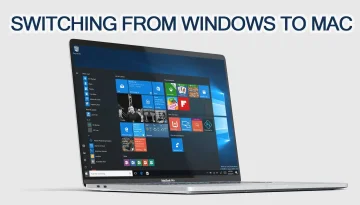Switching from Windows to Mac - Everything You Need to Know
Switching from Windows to a Mac might initially seem daunting, but fear not. This guide aims to make the transition smoother and help macOS feel like home, one step at a time. Let's delve into the intricacies of macOS, starting with fundamental functionalities and gradually exploring advanced features.
Category: How To
1. Mastering Right-Click:
- On Mac, emulate the right-click functionality by holding down the Control key and clicking the trackpad/mouse or using a two-finger tap.
- Activate right-click on a Magic Mouse by going to System Preferences > Mouse > Click Right Side for a secondary click.
2. Understanding the Dock:
- Like the Windows taskbar, the Mac has a Dock for quick access to frequently used apps.
- Utilize Launchpad, akin to the iPhone home screen, to organize and access all downloaded apps.
- Customize the Dock by dragging and dropping apps for easy access.
3. Notification Center and Control Center:
- Access Mac's Notification Center by swiping two fingers or clicking the time and date in the top right corner.
- The Control Center provides quick access to settings like sound outputs, display brightness, Wi-Fi, and Bluetooth.
- Personalize widgets in the Notification Center for a tailored experience.
4. Spotlight Search:
- Spotlight Search, Mac's equivalent to Windows Search, is a powerful tool accessible by pressing the Command + Space bar.
- Conduct comprehensive searches for apps, settings, files, or content within files without leaving the keyboard.
- Visual search capabilities include photos, weather conditions, currency conversions, and quick calculations.
5. Navigating the Finder:
- Finder, equivalent to Windows File Explorer, can be initially confusing but becomes clearer with the "Show Path Bar" feature.
- Customize the sidebar for quick access by pinning important folders.
- Utilize different viewing options with commands like Command + 1 or Command + 2.
- Use the Space bar to preview file content without opening the application.
6. Window Management:
- Toggle between open apps with Command + Tab and between windows of the same app with Command + Tilde key.
- Use Mission Control for an overview of all active windows.
- Explore third-party apps like Magnet, Rectangle, or BetterSnapTool for enhanced window snapping and resizing.
7. App Management and Quitting:
- Quit apps on Mac by clicking the red circle or using Command + Q to ensure resources aren't used in the background.
- Force Quit unresponsive apps using the Apple menu or right-clicking on the app in the dock while holding down the Option key.
8. Scroll Bars and Navigation:
- Adjust scroll bar visibility preferences in System Settings to match the Windows style.
- Use the Alt + Tab shortcut to preview windows and switch between them on Mac using a free and open-source app.
Conclusion:
By embracing these step-by-step adjustments, transitioning from Windows to Mac becomes a seamless experience. Whether it's mastering basic functionalities or exploring advanced features, this guide aims to make macOS feel like a familiar and efficient digital space. Welcome to your new Mac environment!
